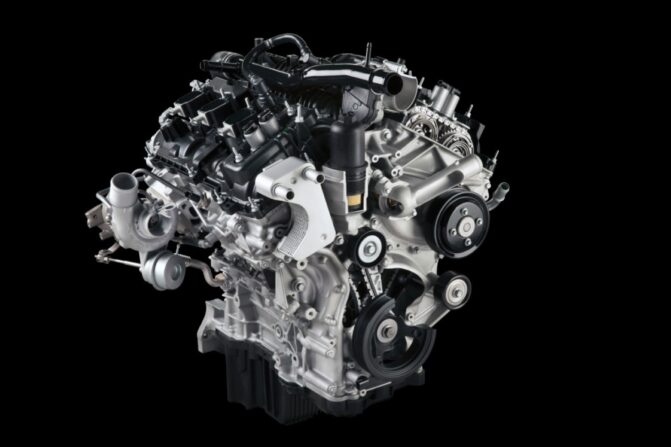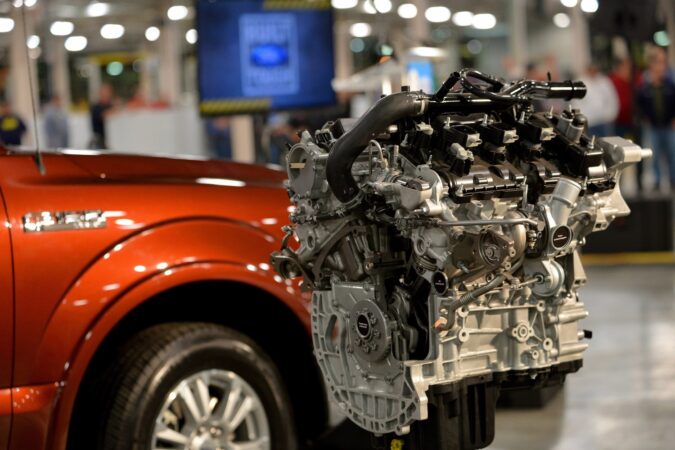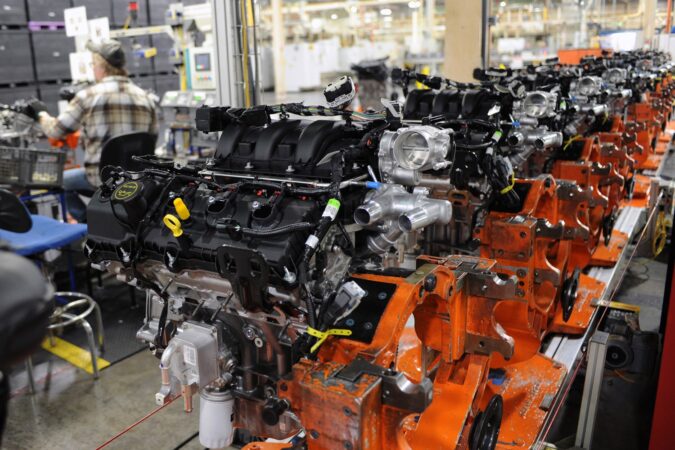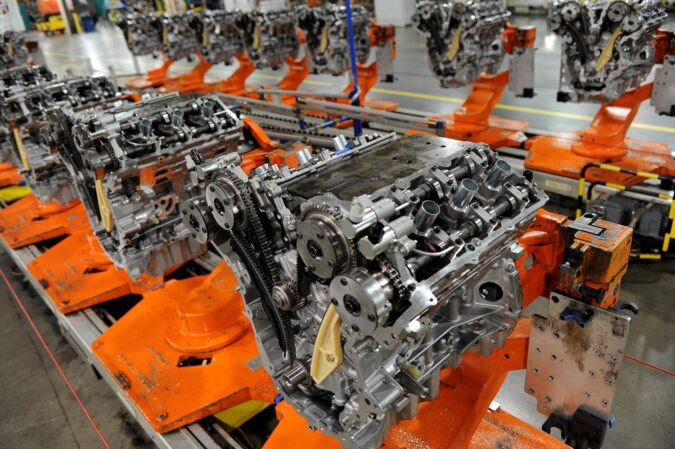If you’re shopping for a new or used Ford F150, choosing the right engine is crucial! Not just for performance, but also for long-term reliability. Now, some F150 engines have a reputation for reliability, while others have been plagued by costly repairs. So, if you’re looking for the most reliable Ford F150 engine, some of the best options that you have include the:
- 3.5-liter EcoBoost V6
- 5.0-liter Coyote V8
- 2.7-liter EcoBoost V6
- 3.5-Liter PowerBoost V6 Hybrid
With a diverse range of trucks within the F150 line-up, from sporty Raptors to the luxurious King Ranch and the workhorse XL trim, despite the poor reliability of some engines, these ones won’t saddle you with expensive repairs, relatively. With that in mind, let’s compare their reliability, common problems, and their performance to find you the right engine.
Ford F-150 Engines
But, before we discuss the reliability of each Ford F150 engine to see which is the best (and most reliable Ford F150 engine option), here’s a rundown of the many engines that Ford makes, just for the F150 pickup truck:
- 3.3-liter Cyclone V6 (could run on flex fuel, available in the XL and XLT trims)
- 2.7-liter EcoBoost twin-turbo V6 (the base engine on almost all F150 trims)
- 3.5-liter EcoBoost twin-turbo V6 (an optional, performance engine in the Lariat trim and up)
- 3.5-liter PowerBoost twin-turbo V6 hybrid (available as an option in the Platinum and Limited trims)
- 5.0-liter Coyote V8 (an optional engine available on most trims)
The aforementioned engines are currently available on the current-gen Ford F150 (which we’ll mainly focus on when assessing their reliability). However, there were a few other noteworthy Ford F150 engines that were discontinued, and used in older model years of the F150:
- 3.0-liter Power Stroke turbo-diesel V6 (discontinued in 2021 due to poor sales)
- 4.6-liter Triton V8 (available in various trims from the late 90s to 2010, now replaced by the Coyote V8)
- 5.8-liter Triton V8 (available in various trims from the late 90s to 2010, now replaced by the Coyote V8)
- 5.0-liter small-block V8
- 5.8-liter Windsor V8
- … And a lot more engines in older or niche trims and variants of the F150, which we won’t be focusing on today.
Best F-150 Motor
With that being said, among all these engines, the most reliable Ford F150 engine options are the 2.7-liter EcoBoost, 3.5-liter EcoBoost, 3.5-liter PowerBoost, and the 5.0 Coyote V8. While we’ll be breaking each engine down in more detail further below, here’s a quick TL;DR cheat sheet, if you need to scan this in record time:
| Engine | Power (HP) | Torque (lb-ft) | Common Issues | Reliability Rating (★) |
|---|---|---|---|---|
| 3.5L EcoBoost V6 (2011–present) | 400 | 500 | Timing chain stretch (Gen 1), carbon buildup (Gen 1) | ★★★★☆ |
| 5.0L Coyote V8 (2011–present) | 400 | 410 | Oil consumption, cam phaser noise | ★★★★☆ |
| 2.7L EcoBoost V6 (2015–present) | 325 | 400 | Carbon buildup, head gasket leaks | ★★★★☆ |
| 3.5L PowerBoost Hybrid (2021–present) | 430 | 570 | Battery issues, limited long-term data | ★★★☆☆ |
Most Reliable Ford F150 Engine (1) – 3.5-Liter EcoBoost V6
The first of the most reliable F150 engine options, and we think the best all-rounder, is the 3.5-liter EcoBoost V6. Available from the 2011 model of the F150, this engine initially made a very healthy 365 horsepower and 420lb-ft of torque. Ford then introduced the second generation (D35) in 2017, now with a power output of 400 horsepower and 500lb-ft of torque.
This D35 variant puts it on par with the 5.0L Coyote V8 in terms of horsepower and makes 90lb-ft more torque. It also gets better mileage than the Coyote, albeit slightly. The Coyote is rated for around 17mpg in the city and 21mpg highway. Meanwhile, the EcoBoost gets 19mpg city and 22mpg highway. Not a big difference, but every bit of fuel saving matters.
Also, if you require heavier towing capacities, the second-generation 3.5L EcoBoost can tow up to 14,000 lbs. That’s a solid 1,000 lbs more than the 5.0 Coyote can tow. However, the first generation can only tow up to about 8,600 lbs, so keep that in mind. Now, as far as reliability is concerned, no matter how reliable an engine is, it’s bound to have issues.
So, when we say that an engine is reliable, it simply means that its problems are negligible or not systemic. These are either easy and cheap to fix, and/or easily avoidable with some preventive maintenance. Or, these issues aren’t reflective of inherent design flaws. That said, here are some of the more common 3.5L EcoBoost V6 issues:
Most Common 3.5 EcoBoost Problems
- Carbon buildup in the intake valve is a common issue in direct injection engines, including the EcoBoost. Walnut blasting the intake ports every 70,000 to 100,000 miles is a good idea to avoid future problems.
- Timing chain issues. The first-generation 3.5 EcoBoost engine was prone to a timing chain failure. And replacing the timing chain assembly is necessary which can cost up to $1,200.
- Spark plugs and ignition coils are likely to fail at around 40,000 to 60,000 miles. Whereas most other cars typically require a change every 70,000 miles. Not a big issue, but worth noting.
Note that the carbon buildup and timing chain issues are only present in the first-generation engine. The later, second-generation D35 EcoBoost has a combination of port and direct injection, reducing carbon buildup in the intake valve and you won’t need to clean it as often.
Ford has also resolved the timing chain issue in the second-generation engine by using two timing chain systems (one for each bank) instead of just one. This means the timing chain is shorter, and Ford has strengthened it by making it thicker. Thus, reducing the possibility of a stretching timing chain.
Consumer Reviews and Common Owner Complaints
While the 3.5-liter EcoBoost V6 powertrain is among the most reliable Ford F150 engine variants out there, as we discussed earlier, it’s not completely immune from issues. So, to give you a better understanding of its real-world reliability, here’s a collection of owner experiences from CarComplaints, F-150 forums, and other sources:
1. Timing Chain and Cam Phaser Problems
- “I had a rattle on cold starts at around 80,000 miles, and it only got worse over time. Turned out to be the cam phasers, and Ford quoted me over $2,500 to fix it. Disappointed since I kept up with maintenance.” – F150 owner on Ford-Trucks.com
- “Bought my 2017 F-150 used with 70k miles. A year later, timing chain stretch became an issue, and the dealer said it wasn’t covered under extended warranty. Ford really needs to address this.” – CarComplaints user
2. Engine Rattle on Startup
- “Every morning, I get this loud rattling noise for the first few seconds. Ford dealer says it’s ‘normal’ and just the way the phasers work, but it sure doesn’t sound normal to me.” – F150 owner on Reddit
- “Phaser noise got so bad that I had to get them replaced. Now it’s running fine, but I’m worried it’ll come back.” – F150 owner on F150Forum.com
3. Sudden Loss of Power (Boost Leak Issues)
- “Truck suddenly lost power while towing my camper. No check engine light, no warning—just wouldn’t accelerate. Turns out the intercooler was full of condensation, which caused the truck to go into limp mode.” – F150 owner on Ford-Trucks.com
- “My 2018 F-150 started hesitating on acceleration at 60k miles. Dealership said it was a boost leak issue common with these engines.” – CarComplaints user
4. Oil Leaks
- “Noticed a small puddle of oil under my truck after parking overnight. Took it to the dealer, and they said the rear main seal was leaking—common issue, apparently. Repair cost was over $1,500.” – F150 owner on F150Forum.com
- “Had a major oil leak on my 2020 EcoBoost at 40,000 miles. Ford issued a TSB, but no recall. Just something you have to deal with, I guess.” – CarComplaints user
5. Carbon Build-Up on Intake Valves
- “I had rough idle and misfires around 90k miles. Shop said it was carbon build-up on the intake valves. The only fix was walnut blasting, which cost me nearly $800.” – F150 owner on Ford-Tremor.com
- “Ford’s direct injection engines are known for carbon buildup. If you’re keeping one long-term, expect to do intake cleaning every 50k miles.” – F150 owner on Reddit
So, while the 3.5-liter EcoBoost V6 is one of Ford’s most popular engines, these real-world owner complaints highlight a few key issues that can arise over time. Thankfully, you can mitigate a lot of this through regular maintenance and proactive repairs. Nevertheless, you should be aware of potential high-cost repairs down the road.
Most Reliable Ford F150 Engine (2) – 5.0-Liter Coyote V8
The 5.0-liter Coyote V8 is the same engine that you’ll find in the 5.0 Mustang GT. There are minor differences, such as the intake manifold, camshaft, and compression. This results in the F150’s Coyote having slightly less horsepower, but more torque – what you need in a big truck. It does seem rather pointless due to the 3.5L EcoBoost being around, though.
Power is the same, and it offers less torque now. However, V8 engines have a certain charm to them. There’s something about that V8 grunt and rumble that V6 engines just can’t replicate. And of course, as they say, no replacement for displacement. Additionally, we know that the Coyote V8 still has more towing capacity than the EcoBoost engine, generally.
But as mentioned, towing capacity depends on the trim. We recommend consulting with a Ford dealer for more details. Anyway, the 5.0L Coyote V8 is a fantastic engine that has very few reliability issues. If you need the towing power, or you just want a V8 in your truck, the Coyote V8 is a fantastic engine. All in all, it’s a great alternative to the EcoBoost.
However, as with the 3.5-liter EcoBoost V6 from earlier, the 5.0-liter Coyote V8 isn’t free of problems. Again, just like the EcoBoost V6, most of these issues aren’t terribly systemic or indicative of major flaws with the Coyote V8. But, quite a handful of owners have documented these issues, so here’s what you need to look out for with the Coyote V8:
Most Common 5.0 Coyote Problems
- Rough running and sudden stalling. The problem stems from a faulty throttle body.
- Rattling noise is also a reported issue in the Coyote V8. This is due to a design flaw in the timing chain assembly.
- Coolant leak due to a defective T-connector in the cooling system lines.
Some issues are isolated to certain model years, mainly the 2016 and 2016 model years. But overall, the Coyote is a very reliable engine with very few widespread issues to worry about. The one issue that seems to persist is the engine rattle which comes from the timing chain. While rattling noises aren’t pleasant, Ford claims that it isn’t a cause for concern.
Additionally, they’ve issued several Technical Service Bulletins (TSB) to resolve this issue. So, there’s no recall, but Ford technicians can resolve this issue. If your F150 suffers from rattling noises and is still under warranty, you should take it to the dealership and have them inspect the problem. So, if a V8’s more your thing, the Coyote is generally quite reliable.
Consumer Reviews and Common Owner Complaints
Yet, while the 5.0-liter Coyote V8 is celebrated as being one of the most reliable Ford F150 engine models around, further praised for its durability and power, like any engine, it has its fair share of problems. To give you a heads-up of what to expect, here’s a selection of the top real-world experiences from owners on CarComplaints, F-150 forums, and other sources:
1. Excessive Oil Consumption
- “My 2018 F-150 5.0 was burning a quart of oil every 1,000 miles. Ford told me it was ‘normal,’ but I’ve never had a truck drink oil like this before. Eventually, they replaced the piston rings under warranty.” – CarComplaints user
- “At 50k miles, I started noticing my oil level dropping fast between changes. The dealer said to monitor it, but it’s been frustrating. Some guys are saying this is just how the Gen 3 Coyote engines are.” – F150 owner on F150Forum.com
2. Cylinder Deactivation and Rough Idle
- “After Ford updated the software, my 5.0 started running rough at idle and low speeds. I think it’s because of the cylinder deactivation system they added in later models. Wish I had stuck with an earlier version.” – F150 owner on Ford-Trucks.com
- “I get a shuddering feeling when coming to a stop, almost like a misfire. Took it in, and they said it’s due to the cylinder deactivation system kicking in.” – F150 owner on Reddit
3. Transmission Clunks and Harsh Shifting
- “I’ve got a 2019 F-150 with the 5.0 and 10-speed, and it shifts rough between 3rd and 4th gear. Dealer says it’s ‘adaptive learning,’ but it hasn’t improved in months.” – F150 owner on F150Forum.com
- “Truck occasionally slams into gear when downshifting. Ford updated the transmission software, which helped a little, but it’s still not perfect.” – CarComplaints user
4. Cam Phaser Tick (Especially on Cold Starts)
- “My truck has developed this annoying ticking noise on cold starts. Ford dealer said it’s ‘normal for the Coyote’ and wouldn’t do anything about it.” – F150 owner on Ford-Trucks.com
- “Started hearing the infamous ‘Coyote tick’ at around 60,000 miles. Some people say it’s harmless, but it sure is annoying.” – F150 owner on Reddit
5. Fuel Pump Control Module Failures
- “Out of nowhere, my truck wouldn’t start. Had it towed to the dealership, and they said it was the fuel pump control module. Common issue, apparently.” – CarComplaints user
- “Lost power on the highway—engine just shut off. Turns out the fuel pump control module failed. I was lucky to be able to coast to the shoulder.” – F150 owner on F150Forum.com
In summary, the 5.0-liter Coyote V8 is a solid and reliable engine, though there are recurring problems that you need to be careful of. Most notably, there are those heavy oil consumption and transmission quirks. Still, these issues aren’t catastrophic, even if they might be a nuisance to deal with! Regular maintenance and keeping an eye on your oil level goes a long way.
Most Reliable Ford F150 Engine (3) – 2.7-Liter EcoBoost V6
Ford offers the 2.7L EcoBoost V6 as the base engine in several F150 trims. It’s also a twin-turbo V6, and since it’s part of the EcoBoost engine family, it shares largely the same architecture with the 3.5L EcoBoost. And yes, it’s a very reliable engine as well. However, it “only” makes 325 horsepower and 375lb-ft of torque in its 1st-generation (2015 – 2017).
And 400lb-ft of torque in the second generation version (2018 – present). While this is a respectable output, it might not be enough for a truck as big as the F150. Sure, it’s rated for 20mpg city and 26mpg highway, a lot more than the 3.5L EcoBoost. But once you tow heavy loads, you might end up using more fuel since you’ll need to mash the gas pedal harder.
Speaking of which, depending on the configuration, the 2.7L EcoBoost can only tow up to 10,000 lbs. So, the 2.7L EcoBoost is also a great and reliable engine, with minimal system faults. But if you have the cash to spare, we recommend getting the 3.5L EcoBoost instead as it offers more power and is overall a better fit for a full-size truck like the Ford F150.
Consumer Reviews and Common Owner Complaints
Displacement-wise, the 2.7-liter EcoBoost V6 might be the smallest one here, but it’s a fantastic engine! It’s been praised for finding that perfect balance between power and fuel efficiency, making it a popular choice for folks who don’t need the full towing capacity of larger engines. However, here are some real-world complaints from owners, just so you know what’s up:
1. Oil Pan Leaks (Plastic Oil Pan Issues)
- “My 2018 F-150 with the 2.7L started leaking oil at around 50,000 miles. Took it in, and the dealer said the plastic oil pan had warped—apparently a common issue. Ford should’ve used aluminum from the start.” – CarComplaints user
- “Noticed oil spots in my driveway, and it turned out to be a bad seal on the plastic oil pan. Replaced it with a new design that supposedly fixes the problem. A recall would’ve been nice.” – F150 owner on Ford-Trucks.com
2. Carbon Buildup on Intake Valves (Due to Direct Injection)
- “Love the performance of my 2.7 EcoBoost, but at 80k miles, I started experiencing rough idling and hesitation. Had to get a walnut blasting done to clean up carbon buildup on the intake valves.” – F150 owner on F150Forum.com
- “These direct-injection engines run great, but carbon buildup is real. My mechanic recommends adding a catch can to help reduce deposits.” – F150 owner on Reddit
3. Head Gasket Failures (Coolant Leaks & Misfires)
- “Check engine light came on, and I noticed white smoke from the exhaust. Turns out the head gasket was leaking coolant into the cylinders. Ford covered it under warranty, but it’s ridiculous that a truck with 40,000 miles would have this issue.” – CarComplaints user
- “Misfires and coolant loss led to a $3,500 repair bill for a blown head gasket. Dealer told me it’s a ‘known issue’ with early 2.7L EcoBoost engines. Not cool, Ford.” – F150 owner on Ford-Trucks.com
4. Cam Phaser Noise at Startup
- “Loud rattle on cold starts that lasts for a few seconds. Dealer said it’s the cam phasers and that Ford updated the design. Replacing them wasn’t cheap.” – F150 owner on F150Forum.com
- “2019 F-150 2.7L started making a nasty rattling sound on startup. Was told it’s normal, but it doesn’t sound normal to me. Hoping it doesn’t get worse.” – F150 owner on Ford-Trucks.com
5. Turbocharger Issues (Boost Leaks & Wastegate Problems)
- “Intercooler pipe blew off while merging onto the highway—instant power loss. Replaced it with a better aftermarket hose. Ford’s stock clamps are garbage.” – F150 owner on Reddit
- “Truck went into limp mode with a ‘turbo underboost’ code. Dealer said the wastegate actuator failed. It was covered under warranty, but it’s frustrating for a relatively low-mileage truck.” – CarComplaints user
All in all, the 2.7-liter EcoBoost V6 is a really solid engine overall. However, you’d have to be wary of oil pan leaks, head gasket failures, and turbo-related issues. Thankfully, while these are fairly frequently reported problems, later model years have seen improvements. Regardless, make sure you stay on top of maintenance to ensure the longevity of your engine.
Most Reliable Ford F150 Engine (4) – 3.5-Liter PowerBoost V6 Hybrid
The 3.5L PowerBoost is the hybrid variant of the 3.5L EcoBoost engine. It’s a mild hybrid configuration, meaning that the engine charges the battery, which then powers the electric motor. So, you can’t plug it in. However, the burst of electric power can reduce gas consumption. The EPA estimates that it will do about 24mpg city and 27mpg highway.
Not a big boost, but still pretty impressive for a full-size truck. On the power side, the PowerBoost has a total of 430 horsepower and 570lb-ft. Slightly more than the EcoBoost, but the tow rating is lower thanks to the extra weight of the hybrid drivetrain. Again, this varies depending on configuration, but the PowerBoost will only be able to tow up to 12,700 lbs.
Another thing to keep in mind is that this powertrain has only been around for about a year now. So, while the engine is likely going to be reliable, there’s no guarantee the hybrid powertrain will be as reliable. And of course, replacing the battery won’t be cheap. If you want a full-size truck that doesn’t use much gas, the PowerBoost is a great option.
But there’s an asterisk about it being one of the most reliable F150 engine options, specifically with the hybrid. For the time being, however, owners have good things to say about it. While it is more complex, given how much it shares with the 3.5 EcoBoost, much of the reliability and refinement may carry over. Though, we’ll keep you posted as more data comes through.
Consumer Reviews and Common Owner Complaints
Quite a unique powertrain from Ford at the time of its launch, the 3.5-liter PowerBoost V6 Hybrid blends the performance of Ford’s EcoBoost engine with hybrid efficiency. Granted, while we’ve found nothing but praise for its performance and fuel economy, owners have reported issues cropping up now and then that you need to be wary of:
1. Hybrid Battery and Electrical System Failures
- “My PowerBoost randomly shut off while driving, and I lost all power. Dealership said the battery control module failed. Left me stranded on the highway—definitely concerning.” – F150 owner on F150Forum.com
- “Got a ‘High Voltage Battery Fault’ warning at 35,000 miles. Ford replaced a module under warranty, but I worry about long-term hybrid reliability.” – CarComplaints user
2. Pro Power Onboard Malfunctions
- “One of the biggest reasons I bought the PowerBoost was for the generator function, but it stopped working out of nowhere. Dealer had no clue how to fix it.” – F150 owner on Ford-Trucks.com
- “Plugged in my power tools, and after 10 minutes, the truck threw a ‘Pro Power System Fault’ error. Seems like a known issue, but Ford hasn’t addressed it properly.” – CarComplaints user
3. Jerky Transmission and Rough Shifting
- “Hybrid system is great when it works, but the 10-speed auto is jerky. Feels like it can’t decide when to switch between gas and electric.” – F150 owner on Reddit
- “At low speeds, my truck has a weird shudder when switching between electric and gas. Took it to the dealer, and they said it’s ‘normal’ for the hybrid. Still annoying.” – CarComplaints user
4. Reduced Towing Capability in Cold Weather
- “PowerBoost tows great—except in winter. My truck refused to use electric power while towing in freezing temps, and the MPG dropped significantly.” – F150 owner on F150Forum.com
- “Ford advertised this as the best towing hybrid, but in cold weather, it struggles. I’ve had multiple warnings about the hybrid system being ‘limited’ due to low temps.” – CarComplaints user
5. Long-Term Battery Degradation Concerns
- “Love the fuel savings, but I’m concerned about battery life. Ford hasn’t really said how long these hybrid batteries will last or how much replacement costs.” – F150 owner on Ford-Trucks.com
- “Battery health is already degrading after 50k miles. I expected some loss, but it’s noticeable when running in full EV mode.” – CarComplaints user
As we discussed thus far, the 3.5-liter PowerBoost V6 Hybrid is a superbly distinct engine that offers strong performance and excellent fuel economy. Nevertheless, some owners have found chinks in its armor, including hybrid system failures, transmission quirks, and cold-weather limitations. Moreover, the long-term reliability of that battery remains a concern, too.




